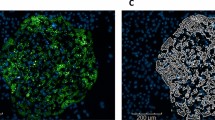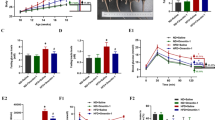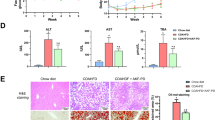Abstract
Although the pathogenesis of non-alcoholic fatty liver disease (NAFLD) is not completely understood, the increased influx of free fatty acids (FFAs) into the liver and the FFA-induced hepatic endoplasmic reticulum (ER) stress are two crucial pathogenic processes in the initiation and development of NAFLD. In this study we investigated the effects of astragaloside IV (AS-IV), a bioactive compound purified from Astragali Radix, on FFA-induced lipid accumulation in hepatocytes and elucidated the underlying mechanisms. Human HepG2 cells and primary murine hepatocytes were exposed to FFAs (1 mmol/L, oleate/palmitate, 2:1 ratio) with or without AS-IV for 24 h. Exposure to FFAs induced marked lipid accumulation in hepatocytes, whereas co-treatment with AS-IV (100 μg/mL) significantly attenuated this phenomenon. Notably, AS-IV (50–200 μg/mL) concentration-dependently enhanced the phosphorylation of AMPK, acetyl-CoA carboxylase (ACC) and SREBP-1c, inhibited the accumulation and nuclear translocation of mature SREBP-1 and subsequently decreased the mRNA levels of lipogenic genes including acc1, fas and scd1. AS-IV treatment also concentration-dependently attenuated FFA-induced hepatic ER stress evidenced by the reduction of the key markers, GRP78, CHOP and p-PERK. Pretreated the cells with the AMPK inhibitor compound C (20 μmol/L) greatly diminished these beneficial effects of AS-IV. Our results demonstrate that AS-IV attenuates FFA-induced ER stress and lipid accumulation in an AMPK-dependent manner in hepatocytes, which supports its use as promising therapeutics for hepatic steatosis.
Similar content being viewed by others
Log in or create a free account to read this content
Gain free access to this article, as well as selected content from this journal and more on nature.com
or
References
Fan JG, Farrell GC . Epidemiology of non-alcoholic fatty liver disease in China. J Hepatol 2009; 50: 204–10.
Cohen JC, Horton JD, Hobbs HH . Human fatty liver disease: old questions and new insights. Science 2011; 332: 1519–23.
Ratziu V, Bellentani S, Cortez-Pinto H, Day C, Marchesini G . A position statement on NAFLD/NASH based on the EASL 2009 special conference. J Hepatol 2010; 53: 372–84.
Williams CD, Stengel J, Asike MI, Torres DM, Shaw J, Contreras M, et al. Prevalence of nonalcoholic fatty liver disease and nonalcoholic steatohepatitis among a largely middle-aged population utilizing ultrasound and liver biopsy: a prospective study. Gastroenterology 2011; 140: 124–31.
Malhi H, Gores GJ . Molecular mechanisms of lipotoxicity in nonalcoholic fatty liver disease. Semin Liver Dis 2008; 28: 360–9.
Torres DM, Williams CD, Harrison SA . Features, diagnosis, and treatment of nonalcoholic fatty liver disease. Clin Gastroenterol Hepatol 2012; 10: 837–58.
Pagliassotti MJ . Endoplasmic reticulum stress in nonalcoholic fatty liver disease. Annu Rev Nutr 2012; 32: 17–33.
Hardie DG . AMPK — sensing energy while talking to other signaling pathways. Cell Metab 2014; 20: 939–52.
Schimmack G, Defronzo RA, Musi N . AMP-activated protein kinase: Role in metabolism and therapeutic implications. Diabetes Obes Metab 2006; 8: 591–602.
Hardie DG . AMPK: a key regulator of energy balance in the single cell and the whole organism. Int J Obes (Lond) 2008; 32: S7–12.
Ahmed MH, Byrne CD . Modulation of sterol regulatory element binding proteins (SREBPs) as potential treatments for non-alcoholic fatty liver disease (NAFLD). Drug Discov Today 2007; 12: 740–7.
Li Y, Xu S, Mihaylova MM, Zheng B, Hou X, Jiang B, et al. AMPK phosphorylates and inhibits SREBP activity to attenuate hepatic steatosis and atherosclerosis in diet-induced insulin-resistant mice. Cell Metab 2011; 13: 376–88.
Lee J, Hong SW, Park SE, Rhee EJ, Park CY, Oh KW, et al. Exendin-4 inhibits the expression of SEPP1 and Fetuin-A via improvement of palmitic acid-induced endoplasmic reticulum stress by AMPK. Endocrinol Metab (Seoul) 2015; 30: 177–84.
Li H, Min Q, Ou-yang C, Lee J, He C, Zou MH, et al. AMPK activation prevents excess nutrient-induced hepatic lipid accumulation by inhibiting mTORC1 signaling and endoplasmic reticulum stress response. Biochim Biophys Acta 2014; 1842: 1844–54.
Wang Y, Wu Z, Li D, Wang D, Wang X, Feng X, et al. Involvement of oxygen-regulated protein 150 in AMP-activated protein kinase-mediated alleviation of lipid-induced endoplasmic reticulum stress. J Biol Chem 2011; 286: 11119–31.
Flamment M, Kammoun HL, Hainault I, Ferre P, Foufelle F . Endoplasmic reticulum stress: a new actor in the development of hepatic steatosis. Curr Opin Lipidol 2010; 21: 239–46.
Basseri S, Austin RC . ER stress and lipogenesis: a slippery slope toward hepatic steatosis. Dev Cell 2008; 15: 795–6.
Lin CL, Huang HC, Lin JK . Theaflavins attenuate hepatic lipid accumulation through activating AMPK in human HepG2 cells. J Lipid Res 2007; 48: 2334–43.
Zang M, Xu S, Maitland-Toolan KA, Zuccollo A, Hou X, Jiang B, et al. Polyphenols stimulate AMP-activated protein kinase, lower lipids, and inhibit accelerated atherosclerosis in diabetic LDL receptor-deficient mice. Diabetes 2006; 55: 2180–91.
Seo MS, Kim JH, Kim HJ, Chang KC, Park SW . Honokiol activates the LKB1-AMPK signaling pathway and attenuates the lipid accumulation in hepatocytes. Toxicol Appl Pharmacol 2015; 284: 113–24.
Juan YC, Kuo YH, Chang CC, Zhang LJ, Lin YY, Hsu CY, et al. Administration of a decoction of sucrose- and polysaccharide-rich radix astragali (Huang Qi) ameliorated insulin resistance and fatty liver but affected beta-cell function in type 2 diabetic rats. Evid Based Complement Alternat Med 2011; 2011: 349807.
Wu H, Gao Y, Shi HL, Qin LY, Huang F, Lan YY, et al. Astragaloside IV improves lipid metabolism in obese mice by alleviation of leptin resistance and regulation of thermogenic network. Sci Rep 2016; 6: 30190.
Zhao Y, Li Q, Zhao W, Li J, Sun Y, Liu K, et al. Astragaloside IV and cycloastragenol are equally effective in inhibition of endoplasmic reticulum stress-associated TXNIP/NLRP3 inflammasome activation in the endothelium. J Ethnopharmacol 2015; 169: 210–8.
Qi H, Wei L, Han Y, Zhang Q, Lau AS, Rong J . Proteomic characterization of the cellular response to chemopreventive triterpenoid astragaloside IV in human hepatocellular carcinoma cell line HepG2. Int J Oncol 2010; 36: 725–35.
Li WC, Ralphs KL, Tosh D . Isolation and culture of adult mouse hepatocytes. Methods Mol Biol 2010; 633: 185–96.
Gomez-Lechon MJ, Donato MT, Martinez-Romero A, Jimenez N, Castell JV, O'Connor JE . A human hepatocellular in vitro model to investigate steatosis. Chem Biol Interact 2007; 165: 106–16.
Donnelly KL, Smith CI, Schwarzenberg SJ, Jessurun J, Boldt MD, Parks EJ . Sources of fatty acids stored in liver and secreted via lipoproteins in patients with nonalcoholic fatty liver disease. J Clin Invest 2005; 115: 1343–51.
Hudgins LC, Hellerstein MK, Seidman CE, Neese RA, Tremaroli JD, Hirsch J . Relationship between carbohydrate-induced hypertriglyceridemia and fatty acid synthesis in lean and obese subjects. J Lipid Res 2000; 41: 595–604.
Mendez-Sanchez N, Arrese M, Zamora-Valdes D, Uribe M . Current concepts in the pathogenesis of nonalcoholic fatty liver disease. Liver Int 2007; 27: 423–33.
Shimano H, Yahagi N, Amemiya-Kudo M, Hasty AH, Osuga J, Tamura Y, et al. Sterol regulatory element-binding protein-1 as a key transcription factor for nutritional induction of lipogenic enzyme genes. J Biol Chem 1999; 274: 35832–9.
Pettinelli P, Del Pozo T, Araya J, Rodrigo R, Araya AV, Smok G, et al. Enhancement in liver SREBP-1c/PPAR-alpha ratio and steatosis in obese patients: correlations with insulin resistance and n-3 long-chain polyunsaturated fatty acid depletion. Biochim Biophys Acta 2009; 1792: 1080–6.
Shimomura I, Bashmakov Y, Horton JD . Increased levels of nuclear SREBP-1c associated with fatty livers in two mouse models of diabetes mellitus. J Biol Chem 1999; 274: 30028–32.
Quan HY, Kim do Y, Kim SJ, Jo HK, Kim GW, Chung SH . Betulinic acid alleviates non-alcoholic fatty liver by inhibiting SREBP1 activity via the AMPK-mTOR-SREBP signaling pathway. Biochem Pharmacol 2013; 85: 1330–40.
Kamikubo R, Kai K, Tsuji-Naito K, Akagawa M . Beta-Caryophyllene attenuates palmitate-induced lipid accumulation through AMPK signaling by activating CB2 receptor in human HepG2 hepatocytes. Mol Nutr Food Res 2016; 60: 2228–42.
Fryer LG, Parbu-Patel A, Carling D . The anti-diabetic drugs rosiglitazone and metformin stimulate AMP-activated protein kinase through distinct signaling pathways. J Biol Chem 2002; 277: 25226–32.
Zhou G, Myers R, Li Y, Chen Y, Shen X, Fenyk-Melody J, et al. Role of AMP-activated protein kinase in mechanism of metformin action. J Clin Invest 2001; 108: 1167–74.
Gentile CL, Frye MA, Pagliassotti MJ . Fatty acids and the endoplasmic reticulum in nonalcoholic fatty liver disease. Biofactors 2011; 37: 8–16.
Leamy AK, Egnatchik RA, Young JD . Molecular mechanisms and the role of saturated fatty acids in the progression of non-alcoholic fatty liver disease. Prog Lipid Res 2013; 52: 165–74.
Kammoun HL, Chabanon H, Hainault I, Luquet S, Magnan C, Koike T, et al. GRP78 expression inhibits insulin and ER stress-induced SREBP-1c activation and reduces hepatic steatosis in mice. J Clin Invest 2009; 119: 1201–15.
Wang ZS, Xiong F, Xie XH, Chen D, Pan JH, Cheng L . Astragaloside IV attenuates proteinuria in streptozotocin-induced diabetic nephropathy via the inhibition of endoplasmic reticulum stress. BMC Nephrol 2015; 16: 44.
Chen Y, Gui D, Chen J, He D, Luo Y, Wang N . Down-regulation of PERK-ATF4-CHOP pathway by Astragaloside IV is associated with the inhibition of endoplasmic reticulum stress-induced podocyte apoptosis in diabetic rats. Cell Physiol Biochem 2014; 33: 1975–87.
Woods A, Johnstone SR, Dickerson K, Leiper FC, Fryer LG, Neumann D, et al. LKB1 is the upstream kinase in the AMP-activated protein kinase cascade. Curr Biol 2003; 13: 2004–8.
Birnbaum MJ . Activating AMP-activated protein kinase without AMP. Mol Cell 2005; 19: 289–90.
Acknowledgements
This study was supported by a grant from the Natural Science Foundation of Guangdong Province, China (2016A030313286).
Author information
Authors and Affiliations
Corresponding authors
Rights and permissions
About this article
Cite this article
Zhou, B., Zhou, Dl., Wei, Xh. et al. Astragaloside IV attenuates free fatty acid-induced ER stress and lipid accumulation in hepatocytes via AMPK activation. Acta Pharmacol Sin 38, 998–1008 (2017). https://doi.org/10.1038/aps.2016.175
Received:
Accepted:
Published:
Issue date:
DOI: https://doi.org/10.1038/aps.2016.175
Keywords
This article is cited by
-
Exploring the immunometabolic potential of Danggui Buxue Decoction for the treatment of IBD-related colorectal cancer
Chinese Medicine (2024)
-
Heat shock proteins (HSPs) in non-alcoholic fatty liver disease (NAFLD): from molecular mechanisms to therapeutic avenues
Biomarker Research (2024)
-
Regulation and targeting of SREBP-1 in hepatocellular carcinoma
Cancer and Metastasis Reviews (2024)
-
Medicinal and edible plants in the treatment of dyslipidemia: advances and prospects
Chinese Medicine (2022)
-
Traditional Chinese Medicine in nonalcoholic fatty liver disease: molecular insights and therapeutic perspectives
Chinese Medicine (2021)



